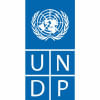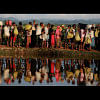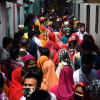Youth workforce to lead future development
Bangladesh has a huge young and productive workforce that will continue to increase until 2030 and can contribute to dramatic socio-economic development.
After 2030, the share of aged population would go up to create pressure on the fiscal management, according to the UNDP's Asia-Pacific Human Development Report 2016, which will be released today in the capital.
Therefore, Bangladesh needs to get robust policies in place to best utilise the demographic dividend and prepare for the imminent challenges, the United Nations Development Programme said in the report titled “Shaping the future: how changing demographics can power human development”.
“When a country has more people to work, save and pay taxes, there is an opportunity to step up growth and development,” Tasneem Mirza, one of the authors of the report said.
However, to utilise this opportunity, the country needs to create not only more jobs but also better jobs ensuring higher wages and productivity, she added.
“Therefore, the government has to have proactive policies that can enhance labour market outcomes or lose significant opportunity,” the economist at the regional bureau for Asia and the Pacific, UNDP, told this correspondent.
Of the country's 16 crore population, 10.5 crore are between 15 and 64 years. This age-group would increase to 13 crore by 2030, according to the report,
Now, the number of people aged above 60 years is 11 million, which would be 22 million in 2030 and 44 million in 2050.
With the rise in the aging population, the country will have to focus more on pension scheme. Then a lesser share of working population would have to pay higher taxes, Tasneem Mirza said.
Until that happens, action-oriented policies for creating quality jobs were recommended in the report to take advantage of the present demographic scenario.
According to Bangladesh Bureau of Statistics, only some 6 lakh jobs were created in the last two years, which should have actually been 26 lakh.
Nearly 74 percent jobless people are youths.
According to the UNDP report, Bangladesh needs to create 25 million jobs between 2016 and 2030, which means 16 lakh new jobs should be available every year.
To stimulate the job market, the government needs to improve the business environment to encourage new businesses as well as foreign investments, said Tasneem Mirza.
Presently, employment in Bangladesh is concentrated mostly in agriculture, readymade garments and informal sector.
In the informal sector, the payments employees get are not enough to maintain a good living, Tasneem said.
Apart from that, only 55 percent of the working age women here are in job market, which must increase, the UNDP said in the report.
The country has 19 percent of its population between 15 and 24 years, who hold immense potentials.
“Bangladesh needs to diversify its economy. There are huge potentials in IT, banking, telecom sectors,” Tasneem said.
Like other Asian countries, Bangladesh has higher savings and low investments. There are scopes for more foreign investments but better infrastructure of transport and energy and political stability are necessary.
Youths have to be involved in policy making and given incentives for entrepreneurship, the author of the report said.
The authorities need to have policies promoting skill-based education as per the market demand, she said.

 For all latest news, follow The Daily Star's Google News channel.
For all latest news, follow The Daily Star's Google News channel. 








Comments